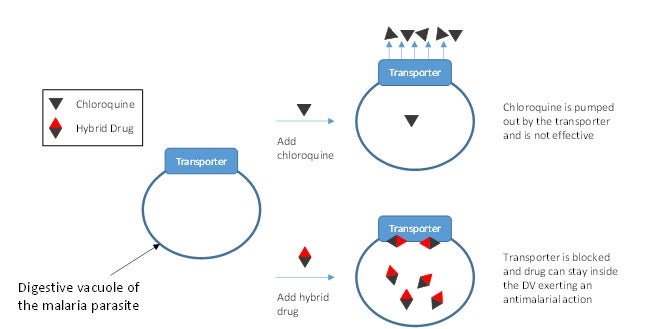Hybrid drug holds promise for combating drug-resistant malaria
Brian DYMOCK (Group Leader, Pharmacy) () June 23, 201623 Jun 2016. NUS scientists have discovered new molecules which have a dual action to combat resistant malaria.
Malaria remains a world health crisis, with 438,000 deaths attributed to the disease in 20151. Artemisinin combination therapy, ACT, is currently the best malaria treatment. However, ART-resistant malaria was recently confirmed in Southeast Asia. Thus, new therapies that are effective against resistant malaria are urgently needed.
Malaria is caused by a parasite which is susceptible to drugs acting on its digestive vacuole (DV), which is like the stomach of the parasite. Following treatment, the DV can become mutated so that the drugs are ‘pumped out’ of the DV, allowing the parasite to continue to live and reproduce.
To tackle this menace, Prof Brian DYMOCK from the Department of Pharmacy in NUS has teamed up with Prof Kevin TAN from the Department of Microbiology & Immunology, Yong Loo Lin School of Medicine, NUS. This cross-faculty team has developed a series of hybrid drugs that do two things – blocking the resistance pump of the parasite while at the same time killing the parasite. This dual acting mechanism includes a killing factor (derived from chloroquine, an old drug which the parasites have become resistant to) and a second component that blocks the mutated DV pump (known as a ‘chemoreversal’ agent). The drug becomes concentrated inside the DV of the drug-resistant parasite and can then effectively kill the parasite.
The new hybrid drugs killed malaria strains grown in the laboratory as well as malaria parasites from patients in Thailand who were resistant to artemisinin. More importantly, the drug was very effective against malaria that was resistant to both chloroquine and artemisinin. Profs Tan and Dymock are continuing to study their hybrid drugs to make them an even more effective therapy for resistant malaria. This work was recently published in the scientific journal Antimicrobial Agents and Chemotherapy2.
This is the first time that a hybrid of chloroquine and a newly discovered chemoreversal factor have been used together in a single novel molecule for this purpose. A single therapy could have several advantages against drug-resistant malaria. Besides being more convenient to take than two separate drugs, it has less risk of drug interactions, may be better absorbed and distributed in the body, and could result in slower development of new resistant strains of malaria.

Figure shows how the old drug chloroquine is pumped out of the DV of the parasite by the transporter, and becomes ineffective, whereas the new hybrid molecules are able to block the transporter and stay inside the DV where they are able to kill the parasite. [Image credit: Brian Dymock]
References
1. World Malaria Report, 2014. World Health Organisation, Geneva.
2. Boudhar, Aicha, XW Ng, CY Loh, WN Chia, ZM Tan, F Nosten, BW Dymock, SW Tan. “Overcoming Chloroquine Resistance in Malaria: Design, Synthesis and Structure-Activity Relationships of Novel Hybrid Compounds.” Antimicrobial Agents and Chemotherapy (2016) doi: 10.1128/AAC.02476-15.


